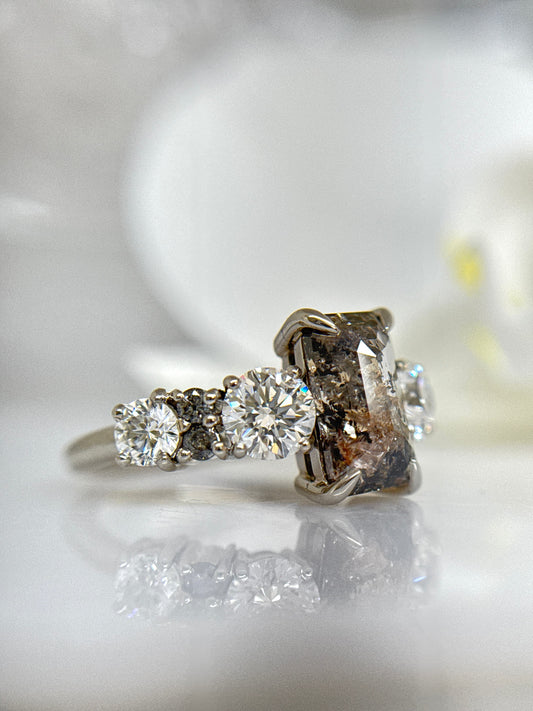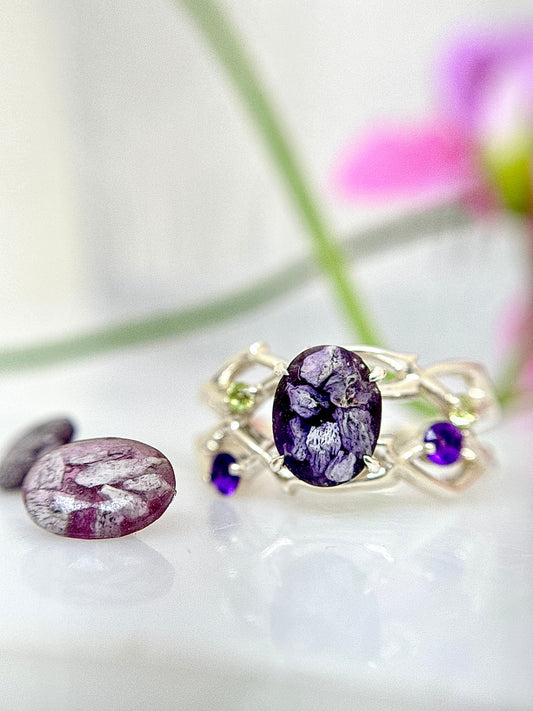There’s a ton of info out there about diamonds. Most of it? Overwhelming. Charts, codes, sparkle jargon — it’s enough to make your head spin before you even see the ring. But after 30+ years at the bench, I’ve cut through the clutter to bring you the only four things that actually matter: the 4 C’s. Think of this as your diamond compass. Follow it, and you’ll always end up somewhere sparkly.
No fluff. No filler. Just real-deal guidance, delivered in my signature no-nonsense, colour-loving way with a little shimmer and mermaid mischief on the side. Let’s make sense of the sparkle.
1. Colour
When we talk about colour in the classic 4 C’s, we mean how white a white diamond is. White diamonds are graded from D (exceptionally white) all the way down to Z (noticeably tinted). D-F is your top tier – bright, icy, and priced accordingly. The closer to D, the higher the price per carat. But warmer tones (like J-K) can be just as beautiful, especially in yellow or rose gold settings.


I always suggest to my clients that we focus on getting the best colour we possibly can — D-F — because that’s what really makes a diamond sparkle. You know, the kind of sparkle that radiates the entire rainbow as you move the stone across your hand or in the sunlight. That beautiful disco ball effect. Plus, a better colour makes the diamond look bigger.
(The exception to this is fancy colour diamonds, such as pinks and blues, which lie outside this colour range).
2. Carat
Carat is the weight of the diamond, not the actual millimetre size.
- A half-carat (0.50ct) diamond should have the same dimensions if it’s cut according to the Brilliant cut, specified proportions.
- However, not all gemstones have the same density. A 1ct Round sapphire will be approx. 6mm, Round emerald approx. 6.5-7mm and a 1ct Round Diamond 6.5mm.


16 x Rubies weigh almost double the weight of 16 x Diamonds.
So if you're comparing across stones? Think apples and oranges — or diamonds and sapphires. From dainty droplets to bold brilliance, every carat carries its own kind of sea-queen power.
3. Cut
Cut is where the mermaid magic happens. It’s about how well the diamond is proportioned — not just the shape. A beautifully cut diamond will catch the light and dazzle. A badly cut one? It just won’t shine the same.
- There are nine popular Brilliant shapes:Round, Oval, Marquise, Pear, Radiant, Emerald, Cushion, Princess, and Heart.
Round is the queen bee and usually the most expensive because the most popular engagement ring is a Round Cut Solitaire. The old supply and demand STORY
But whatever shape you go for, a great cut = great sparkle.
4. Clarity
Clarity looks at what’s happening or visible inside your diamond. Under 10x magnification, but not visible with the naked eye, diamond graders check for tiny inclusions and grade the diamonds accordingly.
- Flawless- no inclusions
- VVS1 – VVS2 – very very slightly included 1 and 2
- VS1-VS2- very slightly included 1 and 2
- Slightly Included 1, 2 and 3
Tiny marks tell a story — but the ones you can’t see? That’s when your diamond truly glows from within. If you can see a black spot or cloud with your naked eye, it’ll affect the price. But if it’s “eye clean”? You’re golden.
Certified Diamonds
Because understanding diamonds should feel more like a treasure hunt than a test, the best advice is to only buy a Diamond which is certified by a verified Diamond Lab, like GIA the largest in the world , DIA, EGL and IGI. This means that you know exactly what you are buying! Diamonds are generally certified from 0.30ct, not smaller stones or Melee.


It’s Time To Sparkle
With a little guidance (and maybe a glass of bubbly), you can understand what you’re looking at and fall in love with the process. Whether you’re ring shopping, building your sparkle wardrobe, or just diamond-curious, the 4 C’s are your starting point.
Still feel a bit dazzled? Let’s chat. I love nothing more than spending an hour or two playing with gems and helping you find the one you’ve always dreamt of!
You bring the questions and I’ll bring the bling!




